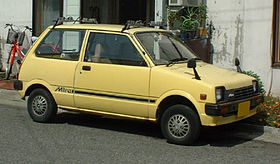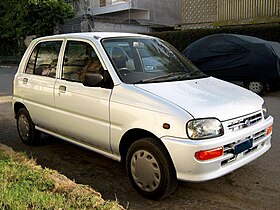Daihatsu Mira
| Daihatsu Mira | |
|---|---|
 |
|
| Overview | |
| Manufacturer | Daihatsu |
| Also called | Daihatsu Cuore Daihatsu Domino Daihatsu Handivan Subaru Pleo (second generation) |
| Production | 1980–present |
| Body and chassis | |
| Class | Kei car or City car |
| Related |
Daihatsu Leeza Daihatsu Move Daihatsu Opti Daihatsu Ceria Perodua Kancil Perodua Kelisa Perodua Viva Daihatsu Ayla |
| Chronology | |
| Predecessor | Daihatsu Max Cuore |
| Daihatsu Mira L55/L60 | |
|---|---|
 |
|
| Overview | |
| Also called | Daihatsu Cuore Daihatsu Domino |
| Production | 1980.06–1985.08 |
| Assembly | Osaka, Japan |
| Body and chassis | |
| Body style | 3-door hatchback/van 5-door hatchback |
| Layout | Front engine, front-wheel drive / four-wheel drive |
| Powertrain | |
| Engine | 547 cc AB10/30/31 I2 547 cc AB35 turbo I2 617 cc AD I2 |
| Transmission | 4/5-speed manual 2-speed Daimatic 2-speed automatic |
| Daihatsu Mira L70 | |
|---|---|

Very late (1990) second generation Mira "Parco"
|
|
| Overview | |
| Also called | Daihatsu Cuore Daihatsu Domino Daihatsu Miracab Norkis Legacy (Philippines) |
| Production | 1985–1990 |
| Assembly | Osaka, Japan |
| Body and chassis | |
| Body style | 3-door hatchback/van 5-door hatchback/van 2-door pick up (Thailand, Phil.) |
| Layout | Front engine, front-wheel drive / four-wheel drive |
| Powertrain | |
| Engine | 547 cc EB I3 796 cc ED-10A I3 847 cc ED-10 I3 |
| Transmission | 4/5-speed manual 2-speed automatic |
| Daihatsu Mira L200 | |
|---|---|

Daihatsu Mira three-door, Australia
|
|
| Overview | |
| Also called | Daihatsu Cuore Daihatsu Domino Daihatsu Handivan |
| Production | 1990–1994 |
| Assembly | Osaka, Japan |
| Body and chassis | |
| Body style | 3-door hatchback/van 5-door hatchback/van |
| Layout | Front engine, front-wheel drive / four-wheel drive |
| Related |
Daihatsu Opti Perodua Kancil Daihatsu Ceria |
| Powertrain | |
| Engine | 547 cc EB I3 659 cc EF I3 847 cc ED10 I3 |
| Transmission | 4/5-speed manual 2/3/4-speed automatic |
| Daihatsu Mira L500 | |
|---|---|
 |
|
| Overview | |
| Also called | Norkis Legacy (Phil.) Daihatsu Cuore |
| Production | 1994–1998 |
| Assembly |
Osaka, Japan Karachi, Pakistan |
| Body and chassis | |
| Body style | 3-door hatchback/van 5-door hatchback/van |
| Layout | Front engine, front-wheel drive / four-wheel drive |
| Related |
Daihatsu Move (L600) Daihatsu Opti |
| Powertrain | |
| Engine | 659 cc EF I3 659 cc JB I4 847 cc ED I3 |
| Transmission | 4/5-speed manual 3/4-speed automatic |
| Daihatsu Mira L700 | |
|---|---|
 |
|
| Overview | |
| Also called | Daihatsu Cuore |
| Production | 1998–2002 |
| Assembly |
Osaka, Japan Serendah, Malaysia (as Kelisa) |
| Body and chassis | |
| Body style | 3/5-door hatchback/van |
| Layout | Front engine, front-wheel drive / four-wheel drive |
| Related |
Daihatsu Move (L900) Daihatsu Mira Gino/Trevis Perodua Kelisa |
| Powertrain | |
| Engine | 659 cc EF I3 (L700/710) 847 cc ED-DE I3 989 cc EJ I3 (L701/711) |
| Transmission | 4/5-speed manual 3/4-speed automatic CVT |
| Daihatsu Mira (L250/L260) | |
|---|---|

Daihatsu Mira Avy
|
|
| Overview | |
| Also called | Daihatsu Charade Daihatsu Cuore |
| Production | 2002–2006 |
| Assembly | Japan: Osaka Malaysia |
| Body and chassis | |
| Body style | 3-door hatchback/van 5-door hatchback/van |
| Layout | Front engine, front-wheel drive / four-wheel drive |
| Related |
Daihatsu Move Perodua Viva |
| Powertrain | |
| Engine | 659 cc EF I3 989 cc EJ I3 |
| Transmission | 5-speed manual 3/4-speed automatic or CVT |
| Dimensions | |
| Wheelbase | 2,390 mm (94.1 in) |
| Length | 3,395 mm (133.7 in) |
| Width | 1,475 mm (58.1 in) |
| Height | 1,500 mm (59.1 in) |
| Daihatsu Mira L275/L285 | |
|---|---|
 |
|
| Overview | |
| Also called |
Daihatsu Charade Daihatsu Cuore |
| Production | 2006–present |
| Assembly | Japan: Osaka |
| Body and chassis | |
| Body style | 3-door hatchback/van 5-door hatchback |
| Layout | Front engine, front-wheel drive / four-wheel drive |
| Powertrain | |
| Engine | 658 cc KF I3 996 cc 1KR-FE I3 |
| Transmission | 5-speed manual 3-speed automatic CVT |
| Dimensions | |
| Wheelbase | 2,490 mm (98.0 in) |
| Length | 3,395 mm (133.7 in) |
| Width | 1,475 mm (58.1 in) |
| Height | 1,540 mm (60.6 in) |
The Daihatsu Mira (also known as the Cuore, Domino, and more recently Charade), is a kei car-type vehicle built by the Japanese car maker Daihatsu. It comes with a variety of options and chassis variations, with the latest variant having four models: "Mira", "Mira AVY", "Mira Gino" and "Mira VAN". The Mira is the latest successor to the line of cars begun with the Daihatsu Fellow of 1966 and was originally introduced as the commercial version of the Cuore. Outside Japan, the Mira has also been offered with an 850 cc or 1000cc engine. In Australia, the two-seater version was marketed as the Daihatsu Handivan and later as the Daihatsu Handi. The name "" is Latin meaning "goal" or "purpose."
The Daihatsu Mira and Cuore replaced the Daihatsu Max Cuore in July 1980. This was replaced by the second generation (L70) of the Mira/Cuore which was introduced in 1985. For most generations there were two engine sizes available: one smaller version, to suit Japanese domestic regulations, of either 550 or 660 cc, and a bigger-engined version for export markets. The L200 variant (1990–94), for instance, came with a three-cylinder 660 cc engine with 40–64 PS (29–47 kW) in Japan, while other parts of the world received a bigger-hearted variant with an 847 cc or 1000 cc. The L500 Mira is the first kei car from Daihatsu to offer a four-cylinder (660 cc) engine.
In July 1980, the Daihatsu Mira and Cuore arrived to replace the Daihatsu Max Cuore. A certain amount of confusion arises from the fact that this, the L55-series, was the first generation Daihatsu Mira but is usually considered the second generation of the Cuore – and that the Mira was originally marketed as the "Mira Cuore". The range was facelifted lightly in May 1982, when the Mira dropped the "Cuore" portion of its name. Also new was the sporty five-speed MGX (three doors only), fitted with radial tires. The autoclutch "Daimatic" transmission was replaced by a fully automatic two-speed unit at the same time. In October 1983, turbocharged and four-wheel drive versions of the Mira van were made available (not in conjunction, however).
The L55 series was sold with two main engines: the two-cylinder AB10 unit of 547 cc, and the slightly larger 617 cc AD unit which was installed in the export-only L60 Cuore. They both featured twin balancing shafts, producing a smoothness and silent operations on par with a traditional four-cylinder engine. In tests, the 617 cc version of the car received plaudits for its refinement as well as its "lively" character and "enthusiastic" performance when compared to European competitors such as the Fiat Panda 30 and the Citroën Visa Club, both also with two-cylinder engines. The main issue was cost: the balance-shaft equipped bicyclinder supposedly cost as much to build as a conventional four-cylinder engine. The car was also commended by Quattroruote for its agile city driving characteristics – although it could hardly be considered fully fit for the autostrada. The 30 PS (22 kW) "big" version has a top speed of 120 km/h (75 mph).
...
Wikipedia
